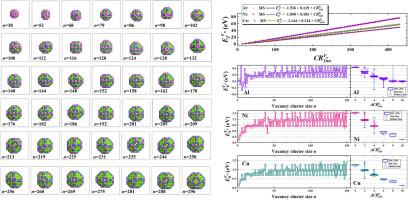A robust modeling framework for predicting nanovoid structures and energetics in FCC metals
IF 8.3
1区 材料科学
Q1 MATERIALS SCIENCE, MULTIDISCIPLINARY
引用次数: 0
Abstract
Understanding the structures and energetics of vacancy-type defects is crucial for comprehending defect evolution in metals, yet current methods face significant challenges, particularly regarding nanovoids in FCC metals. Here, we developed a robust modeling framework to accurately predict the structure and energetics of nanovoids in FCC metals. We demonstrated that stable nanovoid structures can be efficiently determined by maximizing the coordination number among vacancies and identified a linear relationship between nanovoid formation energies and their compactness factors. Notably, we revealed six discrete binding energy levels in nanovoid–vacancy interactions, each correlated solely with changes in compactness factors. Our new model has been validated through first-principles calculations and experiments, demonstrating clear advantages over conventional methods. This model effectively handles arbitrarily sized nanovoids in FCC metals, capturing atomic-scale variations, and providing key insights into vacancy-related damage, along with essential tools for multiscale modeling and the development of new metal interatomic potentials.


求助全文
约1分钟内获得全文
求助全文
来源期刊

Acta Materialia
工程技术-材料科学:综合
CiteScore
16.10
自引率
8.50%
发文量
801
审稿时长
53 days
期刊介绍:
Acta Materialia serves as a platform for publishing full-length, original papers and commissioned overviews that contribute to a profound understanding of the correlation between the processing, structure, and properties of inorganic materials. The journal seeks papers with high impact potential or those that significantly propel the field forward. The scope includes the atomic and molecular arrangements, chemical and electronic structures, and microstructure of materials, focusing on their mechanical or functional behavior across all length scales, including nanostructures.
 求助内容:
求助内容: 应助结果提醒方式:
应助结果提醒方式:


